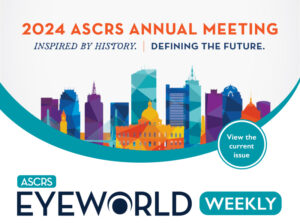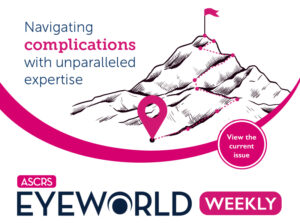
- FDA approves NDA for IOP-lowering drug
- NDA submitted for presbyopia drop
- IND accepted for investigational treatment of persistent corneal epithelial defect
- Topline results from Phase 2 study of novel sedation drug for cataract surgery
- First patient enrolled in Phase 3 trial for investigational TED therapy
- Complimentary access to video journal
- ASCRS news and events
January 6, 2023 • Volume 29, Number 1
FDA approves NDA for IOP-lowering drug
Thea Pharmaceuticals announced FDA approval of its NDA for IYUZEH (latanoprost ophthalmic solution) for IOP lowering in patients with open-angle glaucoma or ocular hypertension. According to the company’s press release, this is the “first and only clinically proven formulation of latanoprost available in the United States that is preservative-free.” The company reported that in randomized, controlled clinical trials, the drug lowered IOP by 3–8 mm Hg from baselines of 19–24 mm Hg.
NDA submitted for presbyopia drop
Orasis Pharmaceuticals submitted an NDA to the FDA for its investigational CSF-1 drop (pilocarpine hydrochloride) for the temporary treatment of presbyopia. According to the company’s press release, the NDA is based on two Phase 3 clinical trials that involved more than 600 patients and both met primary and secondary endpoints, achieving a statistically significant 3 or more line gain in near visual acuity by day 8 of use. The trials showed no loss of 1 or more lines of distance vision. The company reported the most common adverse events being headache (6.8%) and instillation site pain (5.8%); most adverse events were considered mild. CSF-1 is described by Orasis as a “formulation of low-dose pilocarpine and multi-faceted vehicle.”
IND accepted for investigational treatment of persistent corneal epithelial defect
Kala Pharmaceuticals announced that its IND submitted to the FDA for KPI-012 for treatment of persistent corneal epithelial defect (PCED) was accepted. KPI-012 is a human mesenchymal stem cell secretome, according to the company. The company’s press release reported that a Phase 2b clinical trial for KPI-012 for PCED will begin in the first quarter of this year. This study will be multicenter, randomized, double masked, and vehicle controlled with a parallel group, evaluating the safety and efficacy of two different doses of KPI-012 compared to vehicle over a 56-day timeframe. The primary endpoint will be complete healing of the PCED.
Topline results from Phase 2 study of novel sedation drug for cataract surgery
Melt Pharmaceuticals announced the Phase 2 topline results for MELT-300, a sublingual formulation of midazolam (3 mg) and ketamine (50 mg) for sedation for cataract surgery. According to the company’s press release, the drug is designed to dissolve and be absorbed through the sublingual mucosa, allowing for needle-free and opioid-free sedation. The Phase 2 study that included more than 300 patients evaluated MELT-300 against placebo, against sublingual midazolam, and against sublingual ketamine. According to the company’s press release, the study found that MELT-300 was effective at achieving sedation and that it was superior to sublingual administration of midazolam alone. The company plans to bring these results to the FDA for further discussion about development of MELT-300, according to the press release.
First patient enrolled in Phase 3 trial for investigational TED therapy
Viridian Therapeutics enrolled the first patient in its Phase 3 trial investigating the safety and efficacy of VRDN-001 for treatment of active thyroid eye disease (TED). The trial is double blind, placebo controlled, and randomized with the goal of enrolling about 120 patients with active TED and randomizing them across three arms that evaluate different dosing cycles (two arms) or placebo (one arm). The primary efficacy endpoint is the proptosis responder rate, according to the company. The press release described VRDN-001 as a “differentiated monoclonal antibody targeting insulin-like growth factor-1 receptor,” which is a target for treatment of TED.
Complimentary access to video journal
The latest issue of the Video Journal of Cataract, Refractive, & Glaucoma Surgery, founded and edited by Robert Osher, MD, is online now.
ASCRS news and events
- ASCRS Annual Meeting: Tier 1 registration pricing for the ASCRS Annual Meeting, May 5–8, 2023, in San Diego, California, ends later this month. Register now for the best value to attend the meeting.
- Annual Meeting submission opportunity: Three symposia at the ASCRS Annual Meeting are seeking video case submissions until February 1. Find more information here.
- New EyeWorld Online Exclusive: EyeWorld recently interviewed Constance Okeke, MD, about the process of book writing. Read the article here.
- EyeWorld roundtable: EyeWorld Chief Medical Editor Sumit “Sam” Garg, MD, led a roundtable on the topic of presbyopia-correcting drops. Watch the discussion here.
Research highlights
- A retrospective case series of 602 eyes compared the accuracy of postop residual astigmatism prediction with the Barrett toric calculator with predicted vs. measured posterior corneal astigmatism. Biometry and posterior corneal astigmatism measurements were obtained with the IOLMaster700 (Carl Zeiss Meditec). The authors found that the Barrett toric calculator with the measured posterior corneal astigmatism had significantly smaller mean vector prediction errors compared to the Barrett toric calculator with the predicted posterior corneal astigmatism. The authors found that eyes with a predicted residual astigmatism of ≥0.5 D when calculated with the Barrett toric calculator with measured posterior corneal astigmatism had a significantly higher percentage with vector prediction errors of 0.5 D or less. With these findings, the authors concluded that “accuracy of residual astigmatism prediction is improved using the Barrett toric calculator with measured [posterior corneal astigmatism] rather than predicted [posterior corneal astigmatism].” The study is published in the Journal of Cataract & Refractive Surgery.
- A prospective, double-masked, randomized clinical trial published in the American Journal of Ophthalmology sought to evaluate whether crosslinking the donor cornea of the Boston Keratoprosthesis (BKPro) would improve retention in patients who are at high risk for keratolysis. The study enrolled 68 participants and randomized them 1:1 to a crosslinked donor cornea group and a non-crosslinked group. The overall BKPro retention rate, according to the study, was 70% over the mean follow-up time of 93 weeks. Ten BKPros in the crosslinked group and 10 in the non-crosslinked group were removed; 18 of these removals were due to sterile keratolysis, the authors reported. According to the research, there was no difference in retention time until removal between the two groups. There was also no significant difference in retention rate between the two groups. The authors concluded that crosslinking the carrier cornea does not reduce the incidence of sterile keratolysis nor does it increase device retention for those at high risk for failure.
Product news
- MicroSurgical Technology (MST) introduced the TrabEx PRO as an updated tool for irrigating goniectomy.
- NovaSight’s CureSight technology for treatment of amblyopia was introduced to the U.S. market in December.
This issue of EyeWorld Weekly was edited by Stacy Jablonski, Liz Hillman, and Ellen Stodola.
EyeWorld Weekly (ISSN 1089-0319), a digital publication of the American Society of Cataract and Refractive Surgery (ASCRS), is published every Friday, distributed by email, and posted live on Friday.
Medical Editors: Sumit “Sam” Garg, MD, Chief Medical Editor, Mitchell Weikert, MD, Cataract Editor, Karolinne Rocha, MD, PhD, Refractive Editor, Julie Schallhorn, MD, Cornea Editor, Manjool Shah, MD, Glaucoma Editor
For sponsorship opportunities or membership information, contact: ASCRS • 12587 Fair Lakes Circle • Suite 348 • Fairfax, VA 22033 • Phone: 703-591-2220 • Fax: 703-591-0614 • Email: ascrs@ascrs.org
Mention of products or services in EyeWorld Weekly does not constitute an endorsement by ASCRS.
Click here to view our Legal Notice.
Copyright 2023, EyeWorld News Service. All rights reserved.



